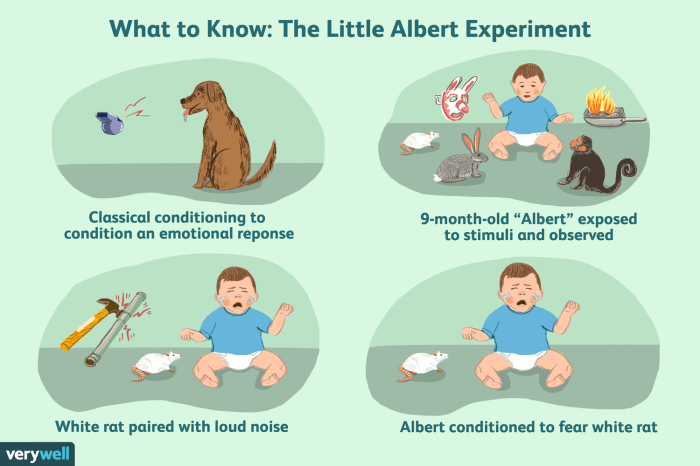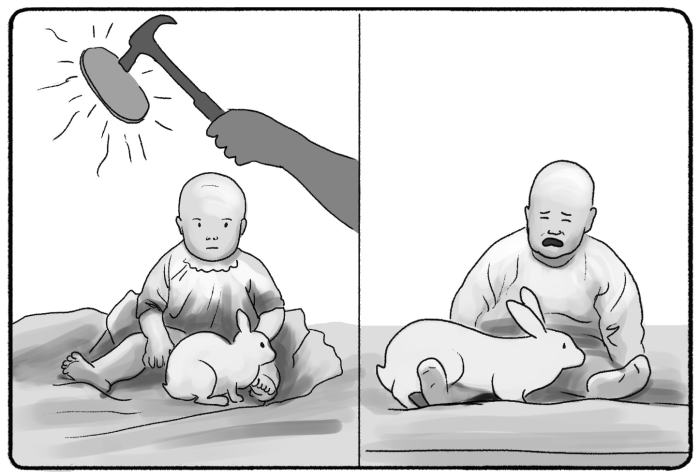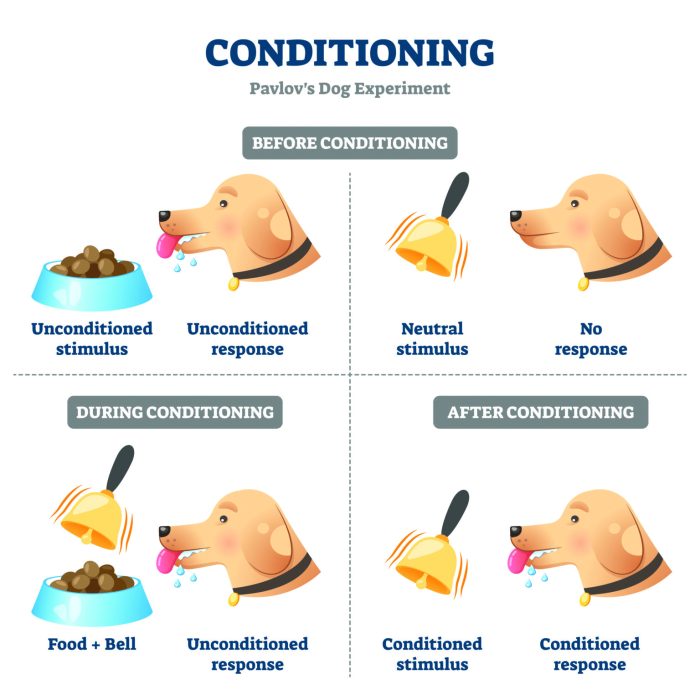After little albert acquired a conditioned fear of rats – After Little Albert: The Acquisition of Conditioned Fear in Rats explores the groundbreaking experiment conducted by John B. Watson and Rosalie Rayner, which revolutionized our understanding of fear conditioning. This seminal study, involving the young boy Albert B., demonstrated how a neutral stimulus (a white rat) could be paired with an aversive stimulus (a loud noise) to elicit a conditioned fear response.
The implications of this research extend far beyond the laboratory, shaping our understanding of the development and treatment of phobias and anxiety disorders.
Little Albert’s case provides a unique window into the complexities of fear conditioning, highlighting the role of classical conditioning, extinction, spontaneous recovery, generalization, and discrimination. This captivating narrative delves into the ethical considerations surrounding the experiment and its lasting impact on the field of psychology.
Conditioned Fear Acquisition
Little Albert’s acquisition of a conditioned fear of rats is a classic example of classical conditioning, a type of learning in which a neutral stimulus (the rat) becomes associated with an aversive stimulus (the loud noise) and subsequently elicits a fear response.
The process began with Little Albert being presented with a white rat, a stimulus that initially did not elicit any fear. However, after repeated pairings of the rat with a loud noise, Albert began to show fear in response to the rat alone.
This fear acquisition was a result of the association formed between the rat (the conditioned stimulus) and the loud noise (the unconditioned stimulus). The loud noise naturally elicited a fear response (the unconditioned response), and through repeated pairings, the rat became a conditioned stimulus that could also elicit a fear response (the conditioned response).
Ethical Implications
The experiment with Little Albert raised significant ethical concerns. The intentional infliction of fear in a child without their consent or understanding of the purpose is considered unethical by modern standards. Additionally, the lack of follow-up with Albert to address the long-term effects of the conditioning further highlights the ethical shortcomings of the experiment.
Extinction and Spontaneous Recovery

Extinction is a process in which a conditioned response is weakened or eliminated by repeatedly presenting the conditioned stimulus without the unconditioned stimulus. In Little Albert’s case, extinction occurred when he was repeatedly presented with the rat without the loud noise.
Over time, his fear response to the rat diminished.
Spontaneous Recovery
Spontaneous recovery refers to the reappearance of a conditioned response after a period of extinction. In Little Albert’s case, after a period of time without exposure to the rat, his fear response to the rat returned. This demonstrates that extinction does not completely erase the conditioned fear but rather weakens it, making it susceptible to reinstatement.
Limitations of Extinction
While extinction can be effective in reducing conditioned fear, it has limitations as a treatment for phobias. Extinction is often temporary, and the fear response can return after a period of time or in response to certain triggers. Additionally, extinction does not address the underlying cognitive and emotional processes that contribute to phobias.
Generalization and Discrimination

Generalization refers to the tendency for a conditioned response to be elicited by stimuli that are similar to the conditioned stimulus. In Little Albert’s case, he generalized his fear response to other furry objects, such as a rabbit or a fur coat.
Discrimination Training
Discrimination training is a technique used to reduce fear generalization. It involves teaching the individual to distinguish between the conditioned stimulus (e.g., a rat) and other similar stimuli (e.g., a rabbit) that do not elicit a fear response. By repeatedly presenting the conditioned stimulus without the unconditioned stimulus and the similar stimuli without the unconditioned stimulus, the individual learns to discriminate between the two and only fear the conditioned stimulus.
Cognitive Factors
Cognitive factors play a role in both generalization and discrimination. Individuals who have a tendency to perceive threats may be more likely to generalize their fear response to similar stimuli. Conversely, individuals who are able to discriminate between different stimuli are more likely to be able to extinguish their fear response to the conditioned stimulus.
Applications and Implications

Little Albert’s case has had a significant impact on the understanding and treatment of phobias. It demonstrated the power of classical conditioning in shaping fear responses and highlighted the importance of early childhood experiences in the development of phobias.
Clinical Implications, After little albert acquired a conditioned fear of rats
The principles of fear conditioning have been applied to develop new treatments for anxiety disorders. Exposure therapy, a form of cognitive-behavioral therapy, involves gradually exposing individuals to feared stimuli in a safe and controlled environment. This helps to extinguish the fear response and teach individuals to discriminate between safe and dangerous stimuli.
Broader Implications
Fear conditioning research has broader implications for understanding human behavior and emotion. It has helped to elucidate the mechanisms underlying fear acquisition, extinction, and generalization. This knowledge has been applied to a variety of areas, including the development of treatments for anxiety disorders, the study of post-traumatic stress disorder, and the understanding of social anxiety.
FAQ Resource: After Little Albert Acquired A Conditioned Fear Of Rats
What is fear conditioning?
Fear conditioning is a type of associative learning in which a neutral stimulus becomes associated with an aversive stimulus, leading to a conditioned fear response.
How was fear conditioning demonstrated in the case of Little Albert?
In the Little Albert experiment, a white rat (neutral stimulus) was paired with a loud noise (aversive stimulus), resulting in Little Albert developing a conditioned fear response to the rat.
What are the ethical implications of the Little Albert experiment?
The Little Albert experiment raised ethical concerns regarding the treatment of human subjects in psychological research, particularly the lack of informed consent and the potential for psychological harm.
How has fear conditioning research contributed to the treatment of phobias and anxiety disorders?
Fear conditioning research has led to the development of effective treatments for phobias and anxiety disorders, such as exposure therapy and cognitive-behavioral therapy, which utilize the principles of extinction and discrimination to reduce fear responses.
